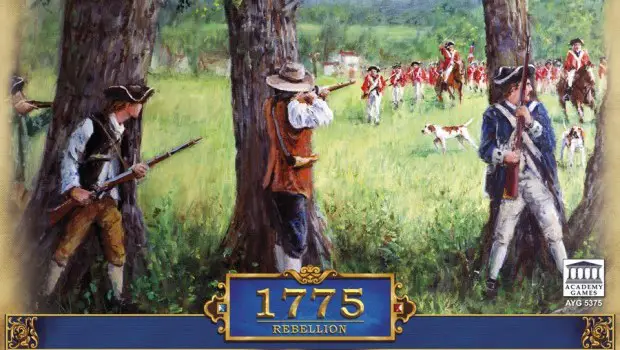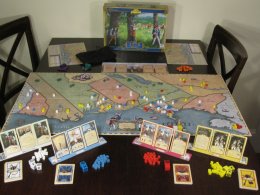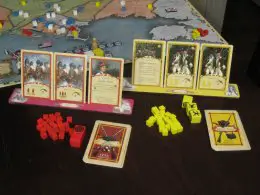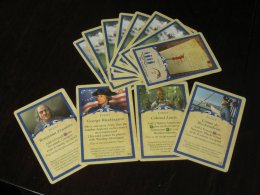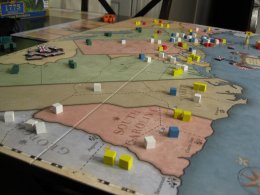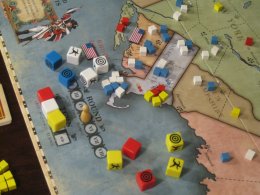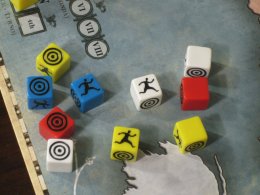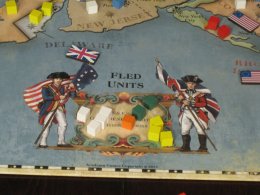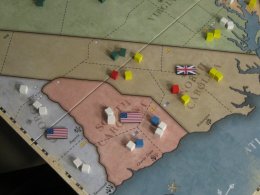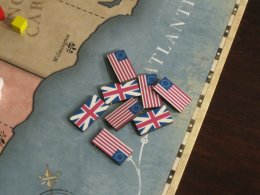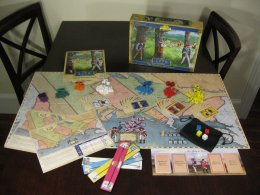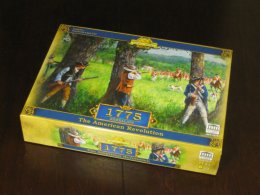Back in the day, you may recall from history class, some dudes got tired of the King’s laws and started a turf war over in Massachusetts. They may have known, they may not have, that they would kick the Red’s butts back to their hood, and gain control of their own territory. Ugg.. that is a terrible representation of the Revolutionary War. But, you know what is a great representation? 1775: Rebellion!
Overview
In 1775, each player takes on the role of one faction in the Revolutionary War and fights for control of the fledgling land of the new world, from Nova Scotia down to Savanna. Each side will be reinforcing, moving and attacking with their force’s armies. The game is played using cards to plan movement and dice to resolve battles in a original and thematic way. You are able to fight for Freedom and Liberty from the Tyranny of the King, or quash the Rebellion, and restore order to the land.
At its core, 1775 is a war game, but a light one that is accessible to all gamers. You will be directly attacking your opponent’s units, while trying to keep control of your own territories. On the British side, there are the British Regulars (fittingly red), and the Loyalist Militia (yellow). The American side is fought by the Patriot Militia (white) and the Continental Army (blue). In a two player game, each player will control both factions of a side, and a 4 player game, two people will play as a team controlling one of the factions. In addition there are German Hessian mercenaries that might be called in by the British; and there are French Army that may help the American forces. These supportive factions are shared by each side respectively. Lest we forget about the Native people as well. The Green Native American units are a wild card fighting with whatever faction reaches them first. Each faction has a set of custom dice used in combat, and a set amount of unit cubes in their color. Each player faction also comes with a deck of twelve cards that will be used to move the game along.
[singlepic id=16558]The game ends when one side’s ‘Treaty of Paris’ cards have been played (signaling the end of the war). At this point the control markers are counted, and the side with the simple majority takes control and wins. Control markers are the key to the game. Whenever there is only one faction in a given territory (American Colony or Canadian Providence) that side gains control and places a marker on the territory. As there are only sixteen territories, the game ends up being a tug of war, fighting over control.
Set up is very simple: The board is pre-seeded with units according to the markings printed. Each side gets to place a few extra units. Players draw cards. And play begins. Turn order is determined randomly, where someone pulls a color cube from the bag. That color then gets to perform their turn.
Each factions turn is made up of four relatively simple stages: Reinforcement, Movement Card, Attack and Clean Up. First off reinforcements. Players take four units from their supply and add all of their fled units (more on that later) that are on the board, then place them in any controlled city. Then one movement card must be played. Cards move one to four armies the number of spaces given by the card. Armies are made up of a subset of units in a region that contain at least one of the current faction’s colors. This means that you can move your allies units on your turn. After moment, a battle occurs at any region with both sides units. Attacks are resolved by each side rolling dice for the units in the battle. The dice have three possible sides: hit (circles), flee (person running) and command decision (blank). Hits are obvious, the opposing player must remove one unit (of any color, their pick) from the region. Flees mean that you must take one cube of that color (if it is a flee on a yellow dice, it affects the Loyalist player) and removes it from the battle, placing it in the fled unit area. The command decision allows for troop movement away from the battle, either to retreat or to another enemy free zone. These rolls go back and forth until only one side remains. The clean up consists of assigning or removing control markers and drawing back up to three cards.
The cards offer a lot of variability in play. Along with the basic movement cards, there are event cards that can be played during your turn that can drastically change the course of the game, from calling in reinforcements, to getting attack bonuses and the ever valuable ship movement (allowing over water troop movements).
Things and Bits
The art and graphic design of 1775: Rebellion are out of the park. The map is a beautiful render of the colonies. The player colors pop on the map making it very easy to see what is going on, and where troops are. The iconography of the game looks good, and makes the game very easy to play and teach. The over all production quality is top notch, from the custom engraved dice, to the high quality card board of the box and the board. My version of the game came pimped out with wooden card holders and control markers, giving it even more polish.
The rules of the game are well laid out and intuitive, with only a few confusing parts that are covered in examples or the FAQ at the end of the rule book. The game is fairly accessible, nothing too complicated. After one turn, players will understand how combat works and how to plan their moves. I don’t know if a group of unexperienced gamers would embrace it, as it *looks* overwhelming, but with some guidance, it is very comfortable to play. I would argue that this is a two player game that can be played with three or four people. In play testing, four players worked ok, but lead to miscommunications or revealed strategy when talking with your teammate. The two player game really shines, with each player controlling one side. The game can be very quick depending on strategy (a minimum of three game rounds are required), introductory games taking 90 – 120 minutes, but after everyone knows what is going on pushing that limit down to 45-90 minutes.
Thoughts
If you have every watched a movie or TV show where they have a montage of the military strategists pushing around units on a map of the battle. You know, with the little wooden sticks and the Generals standing in the background, with a pensive look? Yeah, this game is just like that. You are playing the General commanding faceless troops around the map, trying to ensure victory. The way the dice work in combat, there is not much you can do besides sending your troops in and seeing what happens. 1775 is all about strategy, there is very little tactics, everything is large scale. You have to carefully watch your opponent and try to sniff out their intentions, so you can either prepare your defenses or squash their forces before they can mount an attack.
[singlepic id=16565]Some people (including me) tend to skim over the ‘war game’ title and immediately pass on it. 1775 proved to me that I could enjoy a war game, along with all of the people I played the game with. None of us would ever call ourselves ‘war gamers,’ but we all loved this game. The rule set is simple and streamlined enough, that it is easy to pick up, but the depth and open ended nature of your options on a turn make it interesting to play. I think its size removes it from the ‘gateway game’ category, but it would be a strong contender for second tier, ‘after-the-gateway-game game.’
At first blush, it is easy to assume that all of the factions are the same; however when you attack with Red Coats and Loyalists side by side, you quickly see the differences. Both the number of dice and the sides of the dice have a huge effect. The British Regulars never flee from a fight, and they roll more hits. On the flip side, the Loyalist Militia flee more often, but roll more dice. It may seem like fleeing is horrible, but there is silver lining. Your next turn you get all of those units back. By turn four and five, the Loyalist player is reinforcing with eight or nine units every turn instead of four. This can cause the sting of fled units to go away quickly when you get swift retribution.
I find locking down control of a territory a little fiddly, and a little annoying. For example, if I control New Hampshire with eight units in Portsmouth, and one single enemy unit moves in to the northern region of New Hampshire, I lose control. This one unit move could be due to a command decision, or a troop movement, but either way, it is going to mean I have to waste a movement just to kick one unit out. This is really apparent in the larger territories. This seems to make sense thematically, it just makes for a fiddly aspect of the game that is a drag.
[singlepic id=16563]I did not expect a game with a static map, with static starting positions, to have much replay value, but it had played out very differently the 5 or 6 times I have played. Again, sticking with the historic accuracy, it would be weird if the starting troop positions were any different. The variability comes from the cards and how the players strategize with their cards. An early war ship movement might mean a push for the south, or the arrival of mercenaries might make New York the pivotal territory. Some games end up being intense fighting over one territory, while other games end up being mass land grabs. The equalizing factor is that the number of reinforcements always stays the same. Even if you have one territory, you still get four units, plus your fled guys. Through strategy, you can come back from behind to secure victory.
For mainstream game players, people are going to equate this to Risk. I have to say, 1775 is so much better. I feel a little apathetic about Risk, the troops you are moving are too abstract, the battles are lackluster, you don’t really feel any theme. 1775 implements interesting conflict with a historic theme. One of the people I play tested 1775 with commented that the game felt and looked like a historic battle summary map that you often see see in museums or history books. She said it reminded her of those, but actually made the idea fun and interesting, not boring and bland. The historic theme is augmented by an extensive section in the rule book giving the history of the start of the Revolutionary War, including the history of all of the referenced people and events. This touch adds a very nice thematic polish.
Summary
Components: Top notch components: solid board, colorful cubes, custom engraved dice, high quality cards.
Theme: What better fight to make a war game out of? Incorporation of histrionically themed action cards makes this a true historic game.
Instructions: Intuitive, well laid out, plenty of examples and a good FAQ. Very teachable.
Gameplay: Very little down time, lots of good and diverse choices. Making a good name for ‘war gaming.’
Value: Good for 2 people, ok for more. Not the most versatile game. But, if you have a single gaming buddy, a must buy.
1775: Rebellion
Designed by Beau Beckett and Jeph Stahl
Published by Academy Games
Players: 2-4
Ages: 10+
Play Time: 60-90 minutes
Mechanics: Area Control, Dice Combat, Card Management
Weight: Medium
From Trading in the Mediterranean to FPS, I love games. While I grew up in a house without consoles, PC gaming and board gaming were a large part of my formative years, and continue to influence my life. In this golden age of board gaming, I have jumped in headfirst in to anything table top. As a ludilogical student, I love thinking about how games work, their mechanics, their elegance and most importantly, enjoying how fun they are.
Favorite Board Game (at the moment): Twilight Struggle
Favorite PC Game (base solely on play time): Tie between WoW and DII
Fell free to email me: comments, concerns, questions, feedback, rants, and/or suggestions.

If you have even a passing interest in the Revolutionary War, or if you ever wanted to dip your toe in to a war game, move this game to the top of your 'Must Play' list. 1775: Rebellion is able to take early American History and war gaming, two things that (unfortunately) get a drab and boring label and makes them extraordinarily fun and interesting. People who know nothing of the American Revolutionary War will still find this game engaging and challenging, and may even learn something new. So grab your musket, grab your tin whistle and raise your flag for liberty! Go get 1775.
PROS
- Simple rules
- Complex strategy
- Grand scale
- Supurb components
CONS
- Control mechanic fiddly
- Lots of cubes (don't bump the table)
- Dice combat (if you don't like that kind of thing)
See below for our list of partners and affiliates:
